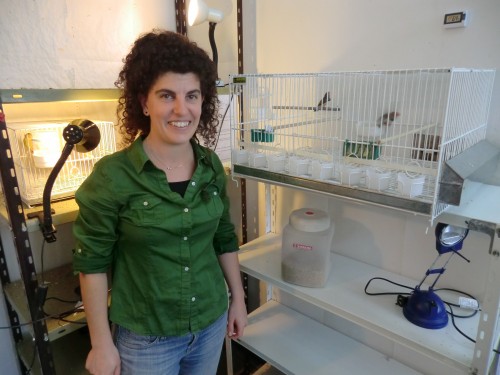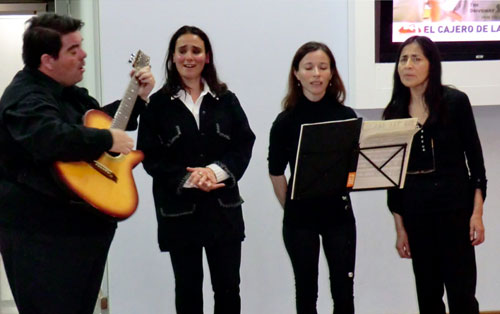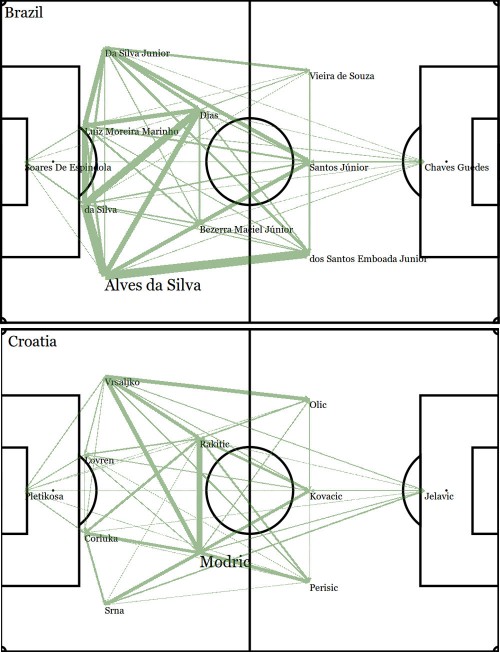Posts by: James Dacey
The physics of twitter
By James Dacey in Buenos Aires, Argentina
Some university physics departments are modern, others are old-fashioned, but by and large they tend to contain similar features: a bunch of physicists and a selection of equipment such as microscopes and lasers. That was why I was caught by surprise in the physics department of the University of Buenos Aires when I stumbled across a collection of caged birds living in the corner of one of the labs. My curiosity was captured and I had to find out more.

Ana Amador in front of a cage of zebra finches.
View all posts by this author | View this author's profile
Connecting physics with Argentine industry

That’s me on the right visiting an optics lab at the University of Buenos Aires.
By James Dacey in Buenos Aires, Argentina
This week, physics PhD students and advanced undergraduates from across Argentina will flock to the University of Buenos Aires for the physics department’s winter school. It’s an annual event where budding researchers spend a few days at the nation’s premier academic institution to learn about some of the latest developments in fundamental research. The year, however, the meeting will be focused on bridging the gap between academia and industry.
I’ve been in Buenos Aires as part of a fact-finding mission to learn about the physics-education system in Argentina. After meeting with various people involved with Argentine physics education, it seems to me that the theme of this year’s winter school at the University of Buenos Aires is indicative of a change in the way physics is being presented to students. The subject is being rebranded from a purely intellectual pursuit into a practical science that can equip students with highly sought-after professional skills. The bigger picture, of course, is that right now the Argentine economy needs all the fresh ideas and workforce it can get!
What can you learn from Descartes?

Taking Descartes back into the physics classroom. (Courtesy: Shutterstock)
By James Dacey in Córdoba, Argentina
What’s the best way to teach tricky physics concepts to students? Naturally, this was one of the questions underpinning many of the talks here at the International Conference of Physics Education (IPCE) in Córdoba. According to a couple of educationalists in Latin America at least, it seems that one approach is to enlist the help of some of the great scientists and philosophers of the past.
Patricia del V. Repossi, a lecturer at the Pontificia Universidad Católica Argentina in Buenos Aires, spoke about how she uses the history of science as a framework for teaching optics. Repossi explained how she had come to realize that some of the students taking her conventional optics course believed that photons are made of the same stuff as “tennis balls”. So, she and her colleagues set about transforming the way they teach the topic – by combining a physics class with a history lesson.
Thinking about thinking

Shining a light on teaching physics. (Courtesy: iStockphoto/Greyfebruary)
By James Dacey in Córdoba, Argentina
There has been a lot of fancy language flying around here at the International Conference on Physics Education (ICPE), which is taking place in Córdoba. Words such as “pedagogy” and “metacognition” roll off the tongues of education researchers as naturally as a particle physicist at CERN saying the words “Higgs boson”.
At first it seemed a bit like a foreign language to me, but I’ve started to realize that one of the recurring ideas at the conference can be described in more everyday terms: thinking about thinking. Teachers should think about the way they think about learning, and the way their students think about learning.
View all posts by this author | View this author's profile
Turning a physics class into a video game

Could computer games like Rock of Ages, which can be played by several people at once using split screens, help inspire better physics courses? (CC BY-SA Rock of Ages by ACE Team)
By James Dacey in Córdoba, Argentina
“When was the last time you heard a student say they wanted a physics course that was long and difficult?”
That was a rhetorical question that physicist and education researcher Ian Beatty put to us today while delivering his keynote talk at the International Conference on Physics Education (ICPE) 2014 here in Argentina. Beatty’s point is that two of the worst things that people say about computer games is that they are too easy or that they end too quickly. Needless to say, he had never heard such protestations from his physics students!
Beatty, a physicist and educational researcher at the University of North Carolina at Greensboro in the US, believes that course creators could learn a trick or two from game designers. He has therefore spent the past three years trying to understand what it is about video games that makes them so appealing to gamers, and how to incorporate some of the underlying principles into a physics course.
Physics education under the microscope in Argentina

A warm welcome from Argentina.
By James Dacey in Córdoba, Argentina
I’m writing this blog entry from the heart of Argentina, following a marathon 30-hour journey from my home in Bristol, UK. It was a trip that included two planes, a few buses, a couple of taxis and several long walks, but I’m finally here in Córdoba – Argentina’s second largest city – to attend this year’s International Conference on Physics Education (ICPE).
The meeting’s all about bringing together people to discuss the latest developments in education – including lecturers, teachers, trainers, students and educational researchers. It’s an event with a global outlook, accompanied by a satellite meeting where local high-school teachers will be discussing issues more focused on their day-to-day experiences. At the registration session, things already took a welcome Argentine twist as we were treated to a performance from some local musicians (see picture above).
View all posts by this author | View this author's profile
Physics World tackles the valley of death
By James Dacey
Many academics believe that they have an idea in them that could lead to a nifty new technology – and make them some cash in the process. But there is a world of difference between discussing an idea in the departmental common room and actually launching a new product to fit into an unexploited niche in the market. One of the biggest challenges that start-up companies face is known as the valley of death, which we have illustrated for you here with this quirky animation.
The voice you hear is that of Stan Reiss, who works for the international venture capitalist firm Matrix Partners. He explains how the valley of death is a metaphor for the financial challenges faced by a spin-off company in the early stages of its development. In this phase, the firm may have a prototype for a product but it might not have the income or the capital to comfortably survive and grow. Often, the company simply runs out of money and falls by the wayside. “There’s a lot of dead bones and skeletons at the end of that valley,” says Reiss.
A network analysis of the FIFA World Cup
By James Dacey
The FIFA World Cup is under way in Brazil as the national teams from 32 nations battle it out on the pitch for the most prestigious prize in football. It is also an exciting month for football fans across the world as everyone suddenly becomes an expert on the game. Offices, bars and cafes around the world echo with the sound of post-match analysis.
This post-match dissection has now been taken to another level by a pair of computer scientists at the University of Pisa in Italy. At the request of Physics World, Paolo Cintia and Luca Pappalardo have carried out a network analysis of the opening match of the tournament, which saw the hosts Brazil defeat Croatia by three goals to one. Cintia and Pappalardo have viewed the match as if it were an evolving network where players represent nodes that interact by passing the ball to each other along “edges”.
View all posts by this author | View this author's profile
Capturing science on film

People enjoying an outdoor screening in Sheffield’s Peace Gardens.
By James Dacey, reporting from Sheffield
For the past few days I’ve been back to the place where I grew up: the city of Sheffield in the north of England. It’s famed for its steel production and snooker, but I’ve been in town for what is billed as the world’s most exciting documentary and digital media festival: Sheffield Doc/Fest. There has been an eclectic mix of films and audio documentaries from around the world to enjoy but I’ve been focusing on a strand of the festival dedicated to “Ideas & Science”.
View all posts by this author | View this author's profile
Meeting the last man to walk on the Moon

Eugene Cernan speaking at Sheffield Doc/Fest.
By James Dacey, reporting from Sheffield
“I wanted to make a film about an old space cowboy” is how British director Mark Craig introduced his new film on Sunday afternoon here at Sheffield Doc/Fest. The Last Man on the Moon takes a fresh look at the the Apollo era through the story of Eugene Cernan, who was the last person to set foot on the lunar surface when he did so in 1972 as commander of Apollo 17.
The documentary interleaves a profile of “Gene” Cernan with NASA archive footage and special effects, focusing on the personal stories of the astronauts and their families. To give you a flavour, the film opens in the present day with close-ups of Cernan’s facial reactions at a rodeo event as he admires the spectacle and the bravery of the men being thrown around on the back of bulls. Later in the film, Cernan recounts his experiences of being rotated rapidly in space during the Gemini 9A and Apollo 10 missions.
Immediately after the showing, Cernan and Craig stayed for a Q&A session and the audience gave an extended standing ovation as the 80-year-old astronaut walked to the front of the auditorium. I was fortunate to catch up with the pair this morning to get some insights into the inspiration for the film and how it was adapted from the book Cernan co-authored in 1999.
View all posts by this author | View this author's profile
